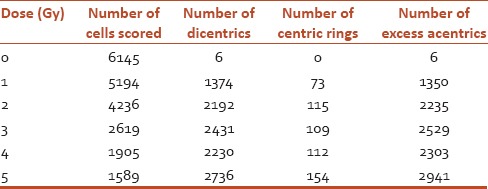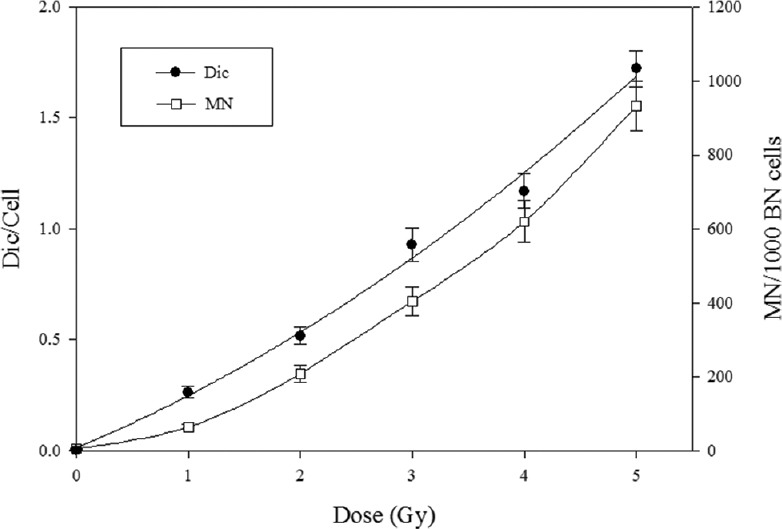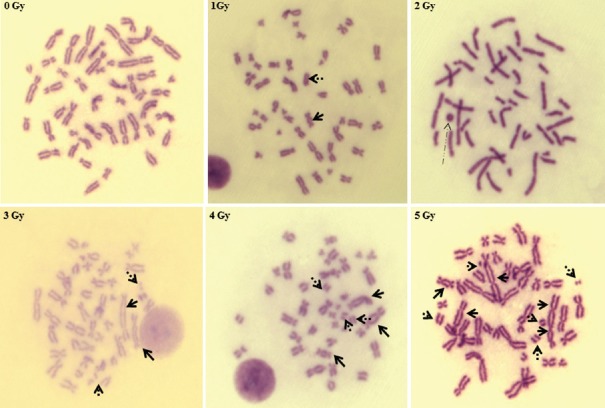Abstract
Biological dosimetry using chromosome aberration analyses in human peripheral blood lymphocytes is suitable and useful tool for estimating the dose when a nuclear or radiological emergency is investigated. Blood samples from five healthy donors were obtained to establish dose-response calibration curves for chromosomal aberrations after exposure to ionizing radiation. In this work, dicentric assay and CBMN assay were compared considering the sensitivity and accuracy of dose estimation. In a total of 21,688 analyzed metaphase spreads, 10,969 dicentric chromosomes, 563 centric rings and 11,364 acentric chromosomes were found. The number of metaphase cells decreased with increasing radiation dose. The centric rings were not found in the non-irradiated control. There was no relationship between radiation dose and acentric ring induction. The frequency of total MN increased in a dose-dependent manner. In comparison with the control value, MN increased about 9, 32, 75, 87, and 52 fold higher after treatment with 1, 2, 3, 4, and 5 Gy, respectively. The results revealed that the mean frequency of chromosomal aberrations, both in dicentric and in micronuclei analyses increased with increasing radiation dose.
Keywords: Biodosimetry, chromosome aberrations, dicentrics, ionizing radiation
Introduction
Increase in the use of radiation sources can also increase the chance of radiation exposure. There have been several nuclear and/or radiation accidents so far, causing radiation injuries of more than 133,000 people.[1] In any incidence of radiation emergencies, estimation of the dose incurred in among the exposed population is very important. Ionizing radiation induces chromosome breakages and produces cytogenetic aberrations in exposed cells.[2] Biological dosimetry using chromosome aberration analysis in human peripheral blood lymphocytes (HPBL) is suitable and useful tool in determining the dose when an investigation is initiated following nuclear or radiological emergency.[3,4] The conventional analysis of dicentric chromosomes in HPBL was suggested by Bender and Gooch in 1962.[5] This assay has been in practice for many years, and it appears to be the most specific method to detect ionizing radiation-induced DNA damage.[6] The dicentric assay technique in HPBL has been shown as the most sensitive biological method and reliable bioindicator of quantifying the radiation dose.[7] In contrast, the micronucleus (MN) assay has advantages over the dicentric assay since it is rapid and requires less specialized expertise, and accordingly, it can be applied to monitor a big population.[8] The cytokinesis-block micronucleus (CBMN) assay is a suitable method for detection of MN in cultured human as well as mammalian cells. The aim of our study was to establish the dose-response curve of radiation-induced chromosome aberrations in HPBL by analyzing the frequency of dicentrics and MN.
Materials and Methods
Radiation exposure and culture conditions
Human peripheral blood was collected from five healthy adult donors. A venipuncture, heparinized whole blood samples were placed into a water bath and incubated at 37°C for 1 h immediately after irradiation in vitro by gamma rays (0, 1, 2, 3, 4, or 5 Gy, 5 min, room temperature). The whole blood samples were cultured in RPMI-1640 containing 10% fetal bovine serum, antibiotic and phytohemagglutinin (PHA-M) at 37°C, and 5% CO2 in humidified atmosphere.
Dicentric and cytokinesis-block micronucleus analysis
Dicentric and CBMN analyses were carried out according to the cytogenetic procedure described earlier by IAEA.[9] The sample for dicentric analysis was cultured for 48 h, including Colcemid solution supplement for provoking mitotic arrest during the last 3 h. The blood for CBMN analysis was cultured for 24 h. Following incubation, cytochalasin B was added to each sample. This culture was maintained for 48 h to block cytokinesis and to induce binucleated cells. After lymphocyte culturing, cells were harvested by centrifugation and treated with 0.075 M potassium chloride solution. The lymphocytes were fixed with Carnoy's solution and were washed twice with fixative solution. A drop of cell suspension from each sample was spread onto a wet, clean glass slide. Staining of the slides was done with fresh Giemsa solution. Finally, the slides were mounted in DPX after air drying. The stained slides were evaluated under a microscope at 200-, 400-, and 1000-fold magnification.
Statistics
Statistical analysis of the data was performed using Microsoft Office Excel 2010 and PASW Statistics 18 (IBM SPSS Inc., Chicago, Il, USA). The calibration curve was made by fitting the data to a linear quadratic equation Y = αD2+ βD + c.
Ethical considerations
The experiments including collection of blood samples from the voluntary donors were started before onset of the Bioethics and Safety Act of Korea (March 23, 2013). However, all the procedures regarding this study were based on obtained consent and followed the legal and regulatory requirements for human experimentations.
Results and Discussion
The dicentric chromosomes and MN of HPBL were analyzed, after in vitro irradiated with gamma rays.
In a total of 21,688 analyzed metaphase spreads, 10,969 dicentric chromosomes, 563 centric rings, and 11,364 acentric chromosomes were found [Table 1]. The number of dicentric, centric ring, and acentric chromosomes in the high-dose irradiation group was higher than in the low-dose irradiation group. The centric rings were not observed in the control group and found only in the 2 Gy irradiated group. Thus, there was no relationship between centric rings and radiation dose [Figure 1].
Table 1.
Pooled data of chromosomal aberrations after in vitro irradiation of human peripheral blood lymphocytes from five donors

Figure 1.
The representative pictuytes of metaphase lymphocytes irradiated with different doses of gamma rays at 1000 magnification. Solid arrows are dicentric chromosomes, and dotted arrows are acentric fragments and centric ring
The frequency of total MN increased in a dose-dependent manner. In comparison with the control value, MN increased about 9-, 32-, 75-, 87-, and 52-fold higher after treatment with 1, 2, 3, 4, and 5 Gy, respectively.
The resulting dose-response calibration curves pooled from the five donors showed a classical linear-quadratic shape [Figure 1]. The curves were reported with 95% lower and upper confidence limits [Figure 2].
Figure 2.

The frequency of dicentrics and micronuclei induced by gamma rays in peripheral blood lymphocytes from five donors. Error bars represent the standard error
The peripheral blood lymphocytes from five healthy donors were used to establish the dose-response calibration curve for chromosomal aberrations induced by ionizing radiation exposure. Our cytogenetic results revealed that the mean frequency of chromosome aberration increased with increasing radiation dose. In this study, dicentric assay and CBMN assay were compared considering the sensitivity and accuracy of dose estimation. This study demonstrated that the inductions of dicentrics and MN in human lymphocytes were intimately related with the irradiation dose. Therefore, these cytogenetic analyses will be helpful for an estimation of radiation exposure dose, and make a role for biological dosimetric analysis in conjunction with the other analytical methods such as translocation and PCC assay.
Financial support and sponsorship
This work has been carried out under the IAEA-CRP (E35008) contract number 17075 and also the Nuclear R and D Program by the Ministry of Science, ICT and Future Planning of Korea.
Conflicts of interest
There are no conflicts of interest.
Acknowledgments
Authors would like to express sincere thanks to Dr. Firouz Darroudi, Dr. Antonina Cebulska-Wasliewska and Dr. Manoor Prakash Hande for their technical advice.
References
- 1.Ricks RC, Berger ME, Holloway EC, Goans RE. REAC/TS Radiation Accident Registry: Update of Accidents in the United States. 2000. [Last accessed on 2000 May 19]. Available from: http://www.irpa.net/Irpa10/cdrom/00325.pdf .
- 2.Amundson SA, Bittner M, Meltzer P, Trent J, Fornace AJ., Jr Biological indicators for the identification of ionizing radiation exposure in humans. Expert Rev Mol Diagn. 2001;1:211–9. doi: 10.1586/14737159.1.2.211. [DOI] [PubMed] [Google Scholar]
- 3.Ainsbury EA, Barquinero JF. Biodosimetric tools for a fast triage of people accidentally exposed to ionising radiation. Statistical and computational aspects. Ann Ist Super Sanita. 2009;45:307–12. [PubMed] [Google Scholar]
- 4.Senthamizhchelvan S, Pant GS, Rath GK, Julka PK, Nair O, Joshi RC, et al. Biodosimetry using chromosome aberrations in human lymphocytes. Radiat Prot Dosimetry. 2007;123:241–5. doi: 10.1093/rpd/ncl109. [DOI] [PubMed] [Google Scholar]
- 5.Bender MA, Gooch PC. Types and rates of x-ray-induced chromosome aberrations in human blood irradiated in vitro. Proc Natl Acad Sci U S A. 1962;48:522–32. doi: 10.1073/pnas.48.4.522. [DOI] [PMC free article] [PubMed] [Google Scholar]
- 6.Lamadrid Boada AI, Romero Aguilera I, Terzoudi GI, González Mesa JE, Pantelias G, García O. Rapid assessment of high-dose radiation exposures through scoring of cell-fusion-induced premature chromosome condensation and ring chromosomes. Mutat Res. 2013;757:45–51. doi: 10.1016/j.mrgentox.2013.06.021. [DOI] [PubMed] [Google Scholar]
- 7.Schröder H, Heimers A. Chromosome aberrations induced in human lymphocytes by in vitro and in vivo x-rays. Mutat Res. 2002;517:167–72. doi: 10.1016/s1383-5718(02)00067-0. [DOI] [PubMed] [Google Scholar]
- 8.Streffer C, Müller WU, Kryscio A, Böcker W. Micronuclei-biological indicator for retrospective dosimetry after exposure to ionizing radiation. Mutat Res. 1998;404:101–5. doi: 10.1016/s0027-5107(98)00100-6. [DOI] [PubMed] [Google Scholar]
- 9.International Atomic Energy Agency. Cytogenetic Dosimetry: Applications in Preparedness for and Response to Radiation Emergencies. Vienna; International Atomic Energy Agency. 2011 [Google Scholar]



